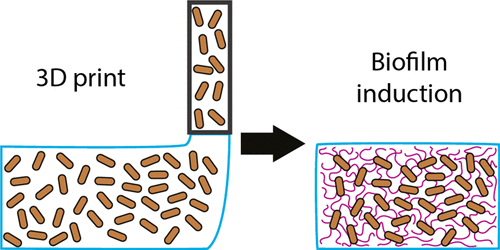当前位置:
X-MOL 学术
›
ACS Synth. Biol.
›
论文详情
Our official English website, www.x-mol.net, welcomes your feedback! (Note: you will need to create a separate account there.)
Printing of Patterned, Engineered E. coli Biofilms with a Low-Cost 3D Printer
ACS Synthetic Biology ( IF 4.7 ) Pub Date : 2018-04-24 00:00:00 , DOI: 10.1021/acssynbio.7b00424 Dominik T. Schmieden 1 , Samantha J. Basalo Vázquez 1 , Héctor Sangüesa 1 , Marit van der Does 1 , Timon Idema 1 , Anne S. Meyer 1, 2
ACS Synthetic Biology ( IF 4.7 ) Pub Date : 2018-04-24 00:00:00 , DOI: 10.1021/acssynbio.7b00424 Dominik T. Schmieden 1 , Samantha J. Basalo Vázquez 1 , Héctor Sangüesa 1 , Marit van der Does 1 , Timon Idema 1 , Anne S. Meyer 1, 2
Affiliation

|
Biofilms can grow on virtually any surface available, with impacts ranging from endangering the lives of patients to degrading unwanted water contaminants. Biofilm research is challenging due to the high degree of biofilm heterogeneity. A method for the production of standardized, reproducible, and patterned biofilm-inspired materials could be a boon for biofilm research and allow for completely new engineering applications. Here, we present such a method, combining 3D printing with genetic engineering. We prototyped a low-cost 3D printer that prints bioink, a suspension of bacteria in a solution of alginate that solidifies on a calcium-containing substrate. We 3D-printed Escherichia coli in different shapes and in discrete layers, after which the cells survived in the printing matrix for at least 1 week. When printed bacteria were induced to form curli fibers, the major proteinaceous extracellular component of E. coli biofilms, they remained adherent to the printing substrate and stably spatially patterned even after treatment with a matrix-dissolving agent, indicating that a biofilm-mimicking structure had formed. This work is the first demonstration of patterned, biofilm-inspired living materials that are produced by genetic control over curli formation in combination with spatial control by 3D printing. These materials could be used as living, functional materials in applications such as water filtration, metal ion sequestration, or civil engineering, and potentially as standardizable models for certain curli-containing biofilms.
中文翻译:

使用低成本3D打印机打印图案化,工程化的大肠杆菌生物膜
生物膜几乎可以在任何可用的表面上生长,其影响范围从危及患者生命到降解不需要的水污染物。由于高度的生物膜异质性,生物膜的研究具有挑战性。生产标准化,可复制和有图案的生物膜启发性材料的方法可能会为生物膜研究带来福音,并允许全新的工程应用。在这里,我们提出了一种将3D打印与基因工程相结合的方法。我们设计了一种低成本的3D打印机原型,该打印机可以打印生物墨水,这是藻酸盐溶液中细菌的悬浮液,该溶液在含钙基质上固化。我们3D打印的大肠杆菌以不同的形状和不连续的层,然后在打印矩阵中的细胞存活至少1周。当打印的细菌被诱导形成卷曲纤维时,卷曲纤维是大肠杆菌的主要蛋白质细胞外成分生物膜,即使在用基质溶解剂处理后,它们也仍然粘附在印刷基材上并稳定地在空间上形成图案,这表明已经形成了生物膜模拟结构。这项工作是对具有图案的,受生物膜启发的生物材料的首次展示,这些生物材料是通过对卷曲的形成进行遗传控制并结合3D打印的空间控制而生产的。这些材料可用作诸如水过滤,金属离子螯合或土木工程等应用中的活性功能材料,并有可能用作某些含卷发生物膜的标准化模型。
更新日期:2018-04-24
中文翻译:

使用低成本3D打印机打印图案化,工程化的大肠杆菌生物膜
生物膜几乎可以在任何可用的表面上生长,其影响范围从危及患者生命到降解不需要的水污染物。由于高度的生物膜异质性,生物膜的研究具有挑战性。生产标准化,可复制和有图案的生物膜启发性材料的方法可能会为生物膜研究带来福音,并允许全新的工程应用。在这里,我们提出了一种将3D打印与基因工程相结合的方法。我们设计了一种低成本的3D打印机原型,该打印机可以打印生物墨水,这是藻酸盐溶液中细菌的悬浮液,该溶液在含钙基质上固化。我们3D打印的大肠杆菌以不同的形状和不连续的层,然后在打印矩阵中的细胞存活至少1周。当打印的细菌被诱导形成卷曲纤维时,卷曲纤维是大肠杆菌的主要蛋白质细胞外成分生物膜,即使在用基质溶解剂处理后,它们也仍然粘附在印刷基材上并稳定地在空间上形成图案,这表明已经形成了生物膜模拟结构。这项工作是对具有图案的,受生物膜启发的生物材料的首次展示,这些生物材料是通过对卷曲的形成进行遗传控制并结合3D打印的空间控制而生产的。这些材料可用作诸如水过滤,金属离子螯合或土木工程等应用中的活性功能材料,并有可能用作某些含卷发生物膜的标准化模型。


























 京公网安备 11010802027423号
京公网安备 11010802027423号